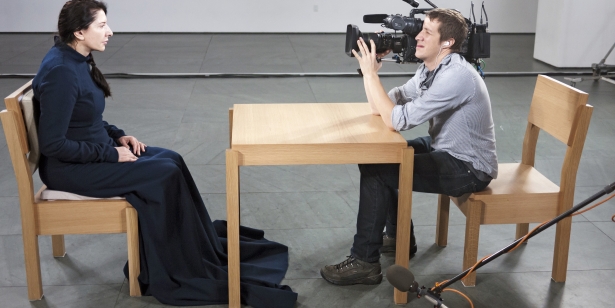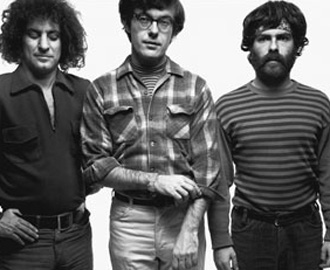Line to Sit With Artist Museum of Modern Art
Marina Abramovic: The Artist Is Present reveals a lot most the most famous living performance creative person—but says piffling virtually her art.

HBO
Perhaps you were 1 of the thousands of museum visitors to appoint Marina Abramovic in a staring contest during her 2010 Museum of Modern Art exhibit The Artist Is Nowadays. Most probable, you weren't. Sitting reverse the "grandmother of performance art" requires a certain degree of mobility: tickets, being physically present in New York, plus stamina and costless time—people waited in lines for hours to behold the Abramovic in the flesh.
Simply with the new documentary Marina Abramovic: The Artist Is Present, which airs today on HBO at 9 p.thousand. EST, manager Matthew Akers lowers the barriers to access. The moving picture follows Abramovic as she prepares and executes her 2010 retrospective show, in which young artists repreformed some of her before work and she unveiled a new piece that sounds similar it could be deployed at Gitmo: to sit entirely still, in silence, in a chair, across from museum visitors, for 750 hours. Information technology's admirable that the moving picture broadens the audience to those far across the borders of Manhattan. But equally the overwrought, emotional footage of the exhibit reveals, the burrow is not the platonic venue to confront Abramovic'due south intense gaze. At one point, Abramovic cheerfully remembers the question she fielded at the offset of her career: "Why is this art?" Somehow, Akers'due south film never quite gets around to answering that question.
Out of all fringe fine art forms—like experimental theater or unwieldy installation sculptures of establish objects—operation art is among the near inaccessible. It'south ane of those things, like the O.J. Simpson verdict or the final episode of The Sopranos, that fling people to the margins of opinion, where every interlocutor becomes a parody of oneself: Abramovic, whose pieces oft border on the ridiculous, as when she drives a machine in endless circles for 16 hours; the pious fine art insiders, nodding knowingly; the Play a trick on News philistines decrying the nudity in the MoMA prove as obscene; and Abramovic's willowy disciples spending a weekend workshop at the artist'south home in Hudson, New York, where they're captured in golden light as they hug copse and weep in her presence. It'south like shooting fish in a barrel to mock performance art (as Sex activity and the Metropolis cheekily did) because it is so challenging, and it's equally easy to puff oneself up pretending to get it. But it's a footling more hard to develop criteria for evaluating performance art since, by design, information technology's so downright weird. What, the uninitiated tin can't help but wonder, makes Abramovic'southward work stellar and worthy of institutional accolades and not the scores of imitators who have proceeded her?
Marina Abramovic: The Artist Is Present does good work restaging the dialogue of performance art insiders (James Franco—of class—and bespectacled, continental-accented curators) and its detractors (Fox News and The New York Mail ). But it misses a big opportunity to give voice to the regular people: the out-of-town tourists whose expressions waver between repulsion and fascination, and the diehards who camped out overnight to sit before the artist. It would have been more interesting to hear the reflections of the grandmother from Indianapolis than Franco. I man sat downwards in forepart of Abramovic 21 times and had that tally tattooed on his arm to commemorate his public stalking. But we never hear what information technology is precisely about this adult female that compels him to spend his leisure time this way, nor practice nosotros come to understand why the people who sit before her cry.
While the film doesn't take up big questions about performance art, information technology does good work revealing the artist herself. She is warmer than the icy, self-flagellating warrior she portrays, and she is refreshingly and sweetly self-deprecating. On pioneering the functioning art movement, she cries, "I'yard 63! I don't desire to be alternative anymore!" After another exhausting viii-hour day of sitting détente, she comments to her banana that she should start getting the phone numbers of cute guys who visit her. Her Spartan upbringing in postal service-war Yugoslavia, nosotros acquire, is one of the motivations propelling her extreme performances. She admits that she needs the audience to make up for a lack of beloved she felt in her childhood from her war-hero parents. This, in other words, is a woman who likes to exist looked at. Every bit MoMA curator Klaus Biesenbach puts it, "Marina is never not performing. The audience is fuel to her, in consequence, a lover."
MORE ON ART



Some of the about electric moments of the film are when she reconnects with her long-fourth dimension collaborator and former lover Ulay. Together, they performed pieces that put her on the map, similar Imponderablia, in which each stood nude in a doorway, forcing members of the public to squeeze through and choose whom to confront. They spent a few idyllic years traversing the European countryside in a van, nomadically performing in villages. Both Ulay and Abramovic get raw addressing the dissolution of their partnership. While waiting for permits to perform The Neat Wall Walk in China, where each started out on opposite ends of the Cracking Wall and walked thousands of kilometers to meet in the middle earlier turning around, Ulay impregnated their translator. "Merely," he says in the flick, "she cheated on me with one of our friends." After their break-up, Abramovic was, in her words, "40, fatty, ugly, and unwanted." Every bit a event, she grew her hair long, got into fashion, and began doing theater pieces—"considering she wanted money," Ulay sneers. He provides a nervy foil, seething with adoration and resentment, as he reunites with his ex-girlfriend who became astoundingly more successful than he.
And how did that success come about? As the documentary shows, information technology's Abramovic'southward intelligence and demented determination that sets her apart from other performance artists attempting the same thing. Who else could sit in that chair for iii months without food or water? (But at that place was a strategically placed cut-out for actual functions, a peachy mystery of the showroom that the movie clears up.) Her work reveals the ugly side of man nature, spanning from the relationship betwixt men and women and having lived in the clutches of history. One author featured in the pic speculated that people were and then taken with Abramovic's because she is a blank slate, a "giant canvas of projections" onto which the audience can assign their own meaning to her work. Whether or not it'due south a work of fine art or not is up to the viewer, but one thing is certain: It is work.
Source: https://www.theatlantic.com/entertainment/archive/2012/07/wait-why-did-that-woman-sit-in-the-moma-for-750-hours/259069/
0 Response to "Line to Sit With Artist Museum of Modern Art"
Post a Comment